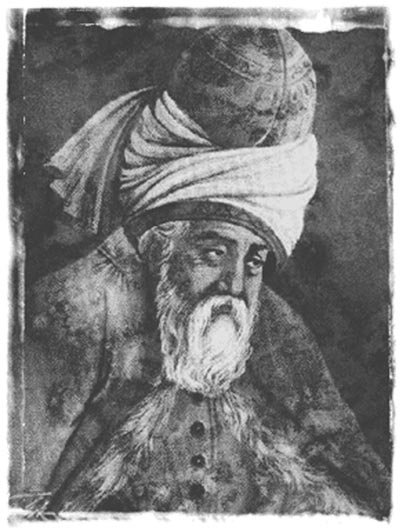
Jalal al-Din Rumi, known to his disciples as Maulana Rumi, was born in Balkh, Ghurid empire (now in Afghanistan). His father, Bahauddin Walad, was a jurist and preacher. The family moved from place to place, perhaps because political reasons or because Bahauddin Walad did not have success as a preacher. Also the times were violent. The Mongols had turned against the Islamic states. They destroyed Balkh in 1221, and eventually conquered Baghdad in 1258. According to some sources, Rumi was visiting Baghdad just before it was sacked by the Mongols. The family settled for some time in Aleppo and Damascus, where Rumi is said to have studied. He perhaps met the great mystic Ibn al-Arabi (d.1240) or his students. From Syria the family travelled to Laranda, where Rumi’s mother, Mu’mine Khatun, died.
Rumi married at the age of eighteen. His first son, Sultan Walad, was born in Larada. After the death of his father in Konya in Anatolia, Rumi continued there as a teacher and theologian. Although Baha’uddin Walad had been known for his visionary powers, and he had written about spiritual love, at that time Rumi was not interested in the mystical tradition. Late in October 1244, Rumi met the wandering dervish called Shamsuddin of Tabriz. Shams did not observe the Shariah, the Holy Law of Islam, and he believed that he is united with the Muhammadan Light. The encounter was the turning point in Rumi’s life.
The holy man left the town as mysteriously as he had appeared. The disappearance of Shams turned Rumi into a poet.
Shams returned again to Konya, but in 1248 he vanished completely. Rumi searched his friend without results, describing it as the search of his own identity : Rumi depicted himself as a man who was created from the wine of Love, but Love was also something that was beyond letters, it was eternal life, fire, tower of light, black lion, an ocean with invisible waves—love was limitless. Rumi’s poetry is full of images of Love.
Rumi wrote some 30,000 verses about his love, longing, and loneliness. They were collected in Diwan-i Shams-i Tabriz, in which he appended Shams’s name as the author. Rumi used often the traditional form of love lyric, the ghazal, which consists generally of five to twelve lines and employs one single rhyme through the poem.
After the death of Shams, Rumi met an illiterate goldsmith, Salahuddin Zarkub, and wrote some poems under Salahuddin’s name.
Salahuddin Zarkub died in 1258. Hasamuddin Chelebi, one of Rumi’s students, became for him a new mirror of Love in the world, which is the mirror of God. “The wine is one; only the vessel’s changed—” Rumi said in a poem. During the following years, he composed the nearly 26,000 couplets of the Masnavi-ye Manavi, but he did not mention Shams’s name anymore.
It is believed that Rumi created his poems in a state of ecstasy, accompanying his verses by a whirling dance. After Shams’s death Rumi had started in his grief to circle a pole in his garden, and speak the poetry, which was written down by scribes.
Rumi died in Konya on December 17, 1273. His cat died a week later and was buried close to his master. Rumi remained a major influence upon Sufism. His followers have sometimes claimed to have experienced his nearness.

